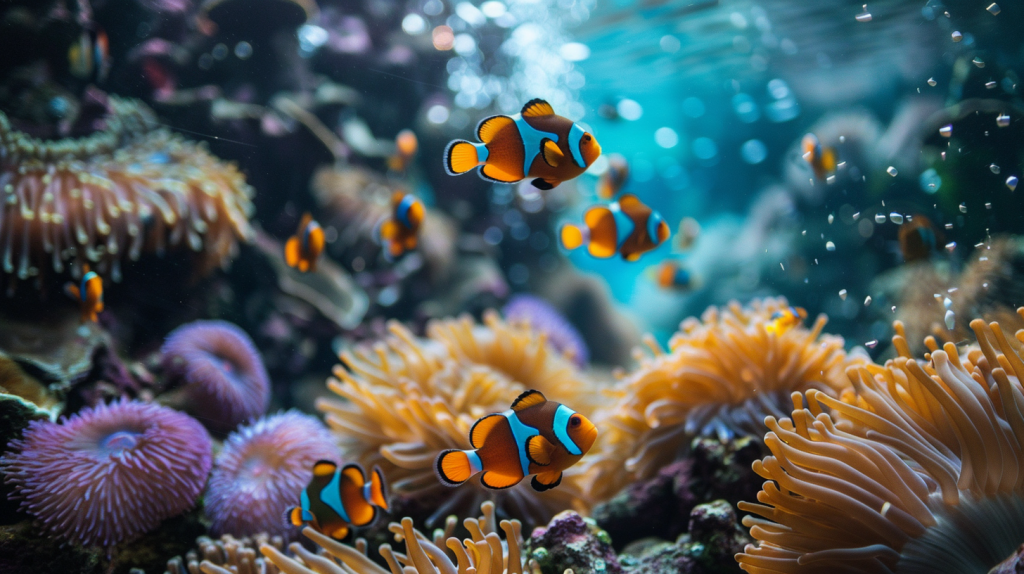The ocean, covering more than 70% of the Earth’s surface, is a vast and mysterious place teeming with life. From the smallest plankton to the largest whales, the ocean is home to a diverse range of organisms. Let’s dive into the fascinating world of ocean life and explore some of its incredible inhabitants.

The Microscopic World: Plankton
At the base of the ocean’s food chain are plankton, tiny organisms that drift with the currents. Plankton can be divided into two main categories: phytoplankton and zooplankton.
Phytoplankton are microscopic plants that perform photosynthesis, converting sunlight into energy. They produce more than half of the Earth’s oxygen, making them vital to life on our planet.
Zooplankton, on the other hand, are tiny animals that feed on phytoplankton. They are a crucial food source for many marine creatures, including fish, whales, and seabirds.
Coral Reefs: Underwater Cities
Coral reefs are among the most diverse and vibrant ecosystems on Earth. These underwater structures are formed by colonies of tiny animals called coral polyps, which secrete calcium carbonate to build their skeletons.
Coral reefs provide habitat and food for a multitude of marine species. They are often referred to as the “rainforests of the sea” due to their incredible biodiversity. Fish, crustaceans, mollusks, and many other organisms thrive in these underwater cities.
The Open Ocean: Pelagic Zone
The open ocean, or pelagic zone, is the largest habitat on Earth. It extends from the surface to the deep waters and is home to a wide variety of marine life.
Fish are the most abundant inhabitants of the pelagic zone. From tiny sardines to massive tuna, fish are adapted to life in the open ocean. They have streamlined bodies for efficient swimming and often travel in schools for protection.
Marine mammals, such as dolphins and whales, also inhabit the open ocean. These intelligent creatures are known for their complex behaviors and social structures. Dolphins are highly social and often seen in pods, while whales migrate long distances to feed and breed.
The Deep Sea: A World of Extremes
The deep sea is one of the most extreme and least explored environments on Earth. It begins at a depth of about 200 meters and extends to the ocean floor, where pressure is immense, and sunlight is absent.
Despite the harsh conditions, the deep sea is teeming with life. Deep-sea fish have adapted to the darkness and high pressure with unique features, such as bioluminescence (the ability to produce light) and large eyes to see in the dim light.
Giant squids and other mysterious creatures inhabit the deep sea. These elusive animals are rarely seen by humans but have captured our imagination for centuries.
The Ocean Floor: Benthic Zone
The ocean floor, or benthic zone, is a diverse and complex habitat. It includes areas like the continental shelf, abyssal plains, and deep-sea trenches.
Benthos are organisms that live on, in, or near the ocean floor. This includes a wide variety of creatures, from crabs and starfish to sea cucumbers and tube worms. Many benthic organisms have adapted to survive in the dark, cold, and high-pressure environment of the deep ocean.
Importance of Ocean Life
Ocean life is essential to the health of our planet. Marine organisms play a crucial role in the Earth’s ecosystems and climate. Phytoplankton, for example, produce oxygen and help regulate the carbon cycle. Coral reefs protect coastlines from erosion and provide habitat for many species.
Marine life also supports human economies and cultures. Fisheries provide a vital source of food and livelihood for millions of people worldwide. The ocean is also a source of recreation and inspiration, drawing people to its shores for activities like swimming, diving, and boating.
Threats to Ocean Life
Despite its importance, ocean life faces numerous threats. Climate change is causing ocean temperatures to rise and making the water more acidic. This affects marine organisms, especially those with calcium carbonate shells or skeletons, like corals and shellfish.
Pollution is another significant threat. Plastic waste, oil spills, and chemicals can harm marine life and disrupt ecosystems. Overfishing also poses a risk, as it depletes fish populations and disrupts the balance of marine food webs.
Protecting Our Oceans
Efforts are underway to protect and preserve ocean life. Marine protected areas (MPAs) are regions where human activity is restricted to conserve marine ecosystems. These areas help protect habitats and allow fish populations to recover.
Reducing pollution is also critical. Initiatives to reduce plastic waste, clean up beaches, and regulate pollutants are essential steps in safeguarding our oceans. Sustainable fishing practices can help ensure that fish populations remain healthy and viable for future generations.

The ocean is a wondrous and vital part of our planet, filled with an incredible array of life. From the tiniest plankton to the largest whales, marine organisms play crucial roles in maintaining the health of the Earth. However, they face significant challenges, and it is our responsibility to protect and preserve these amazing ecosystems. By understanding and appreciating the diversity of ocean life, we can work towards a sustainable future for our oceans and the countless creatures that call them home.
